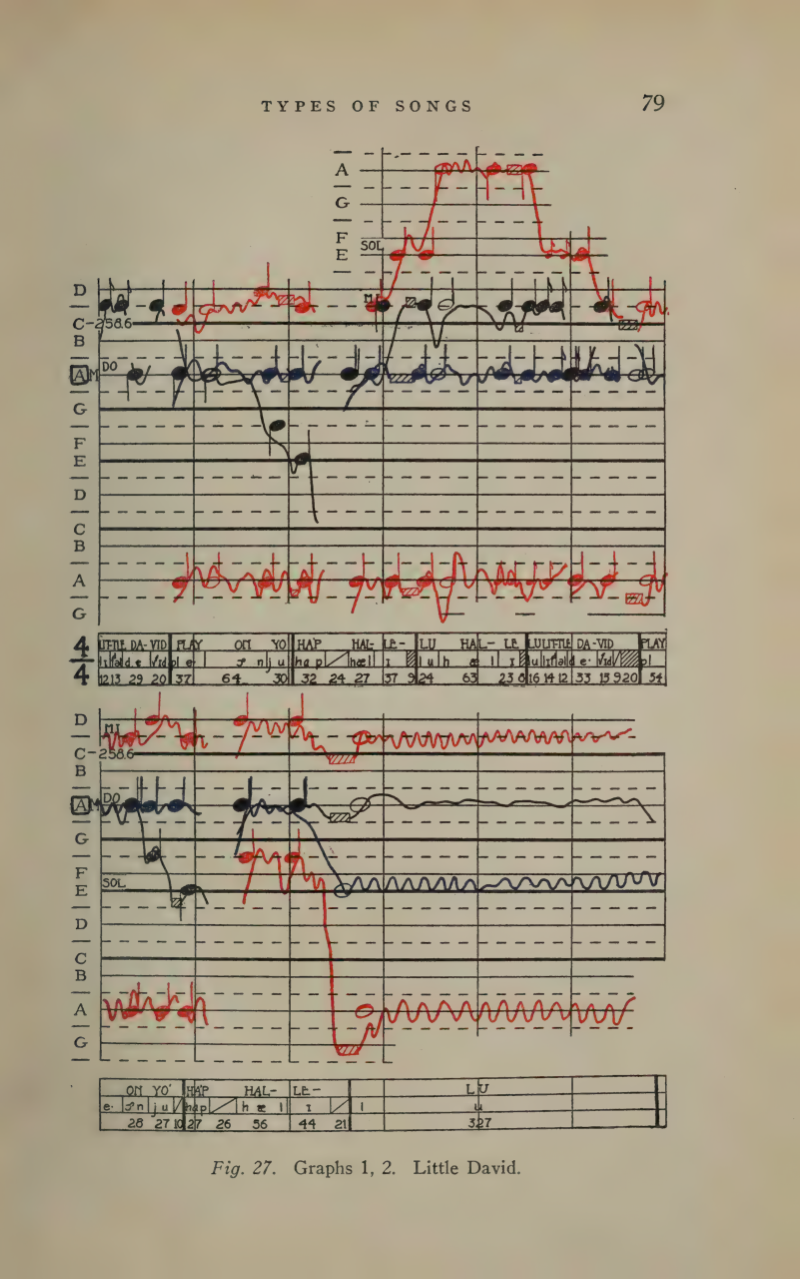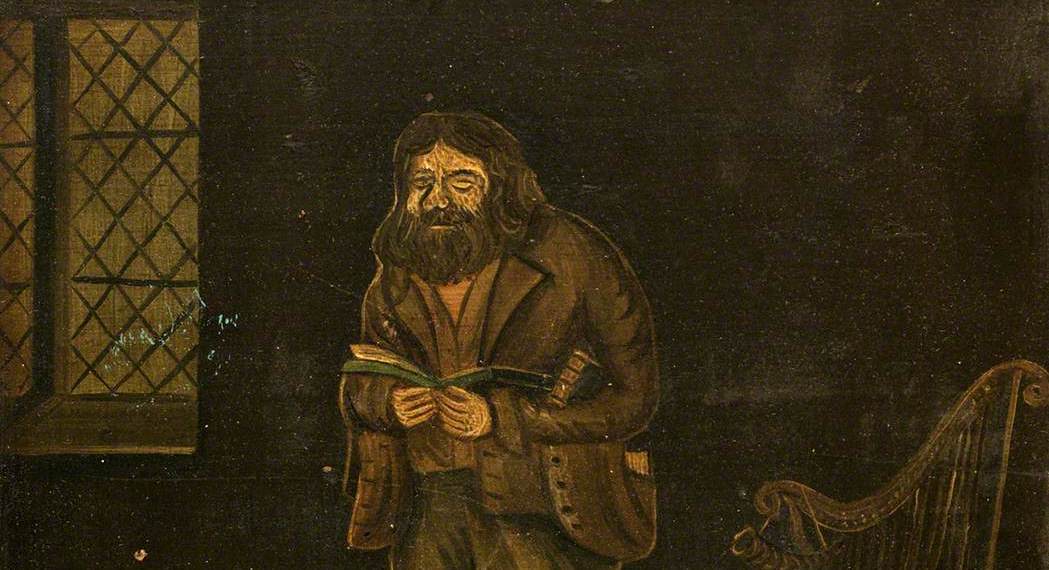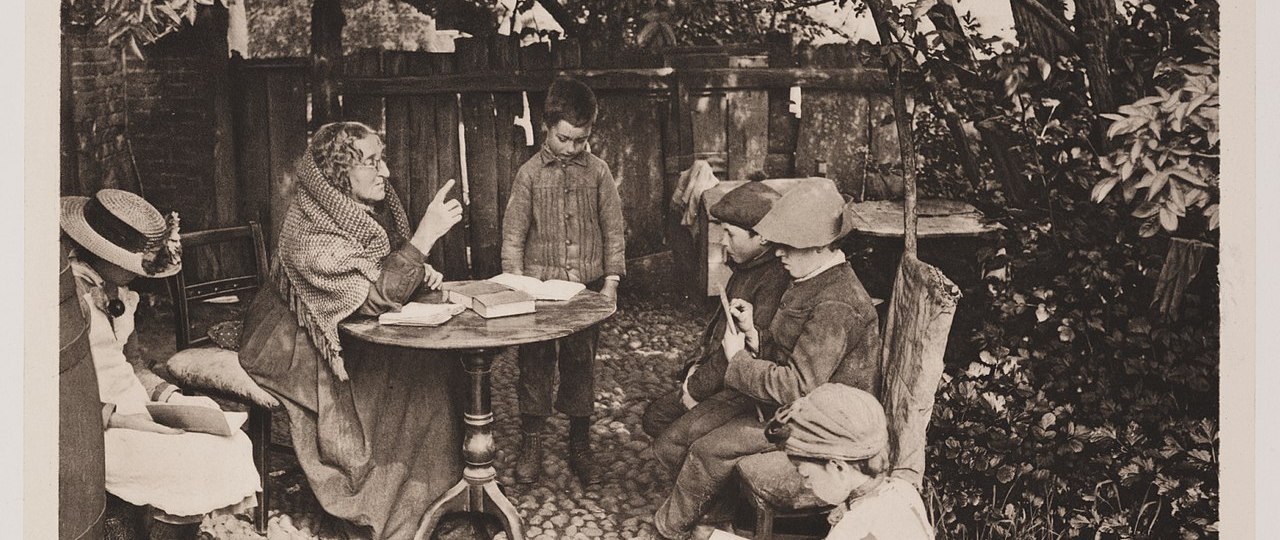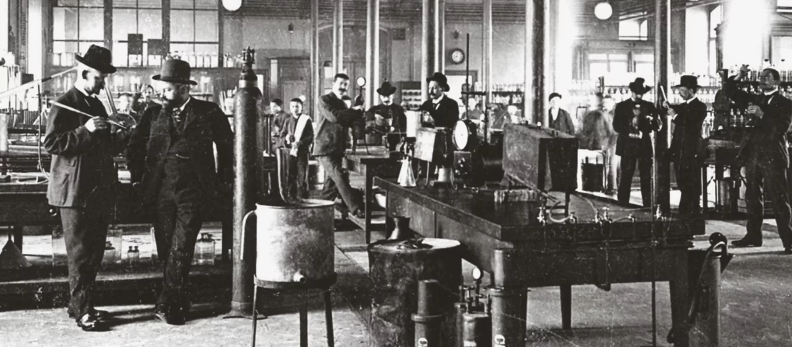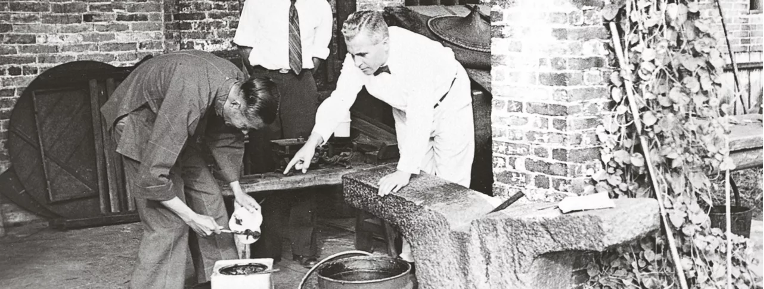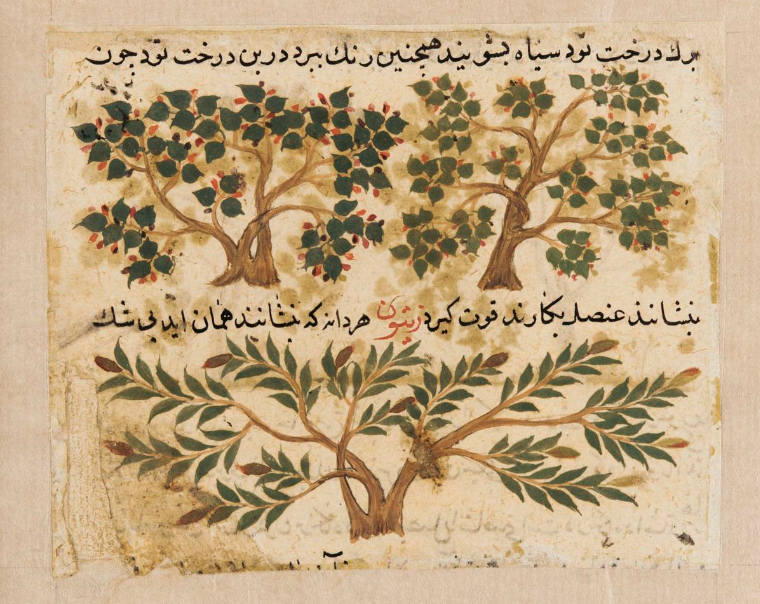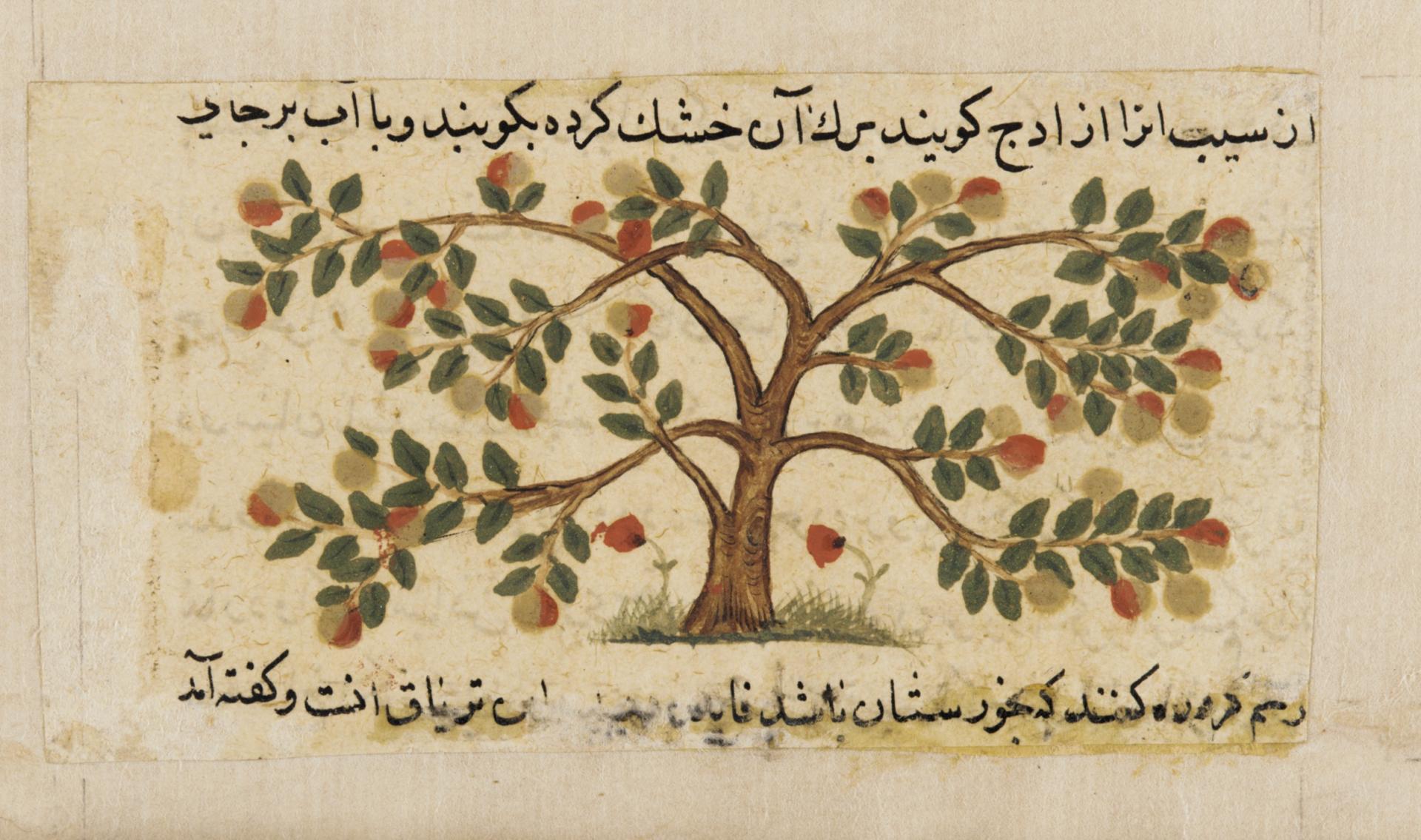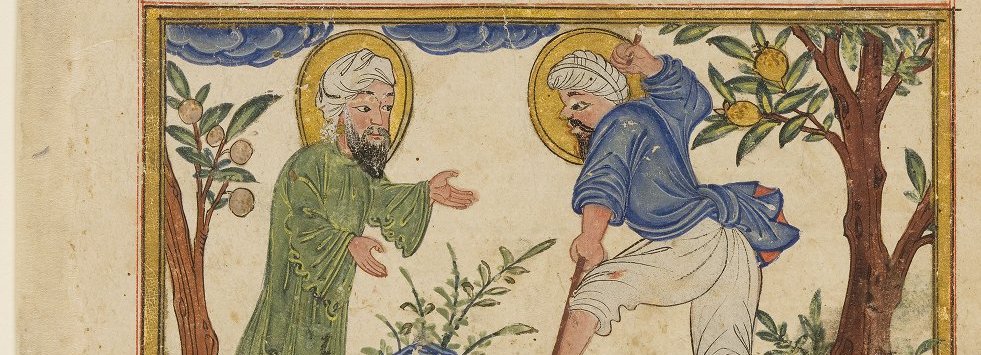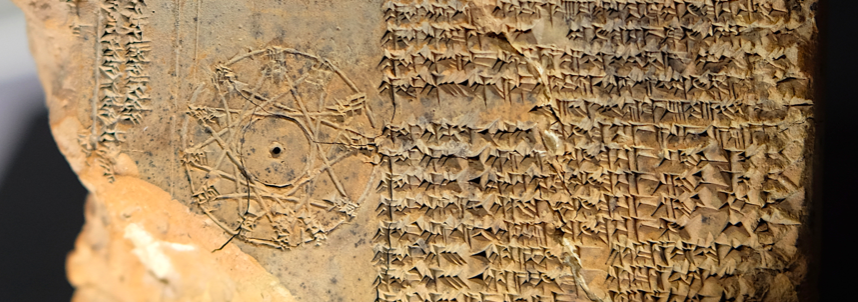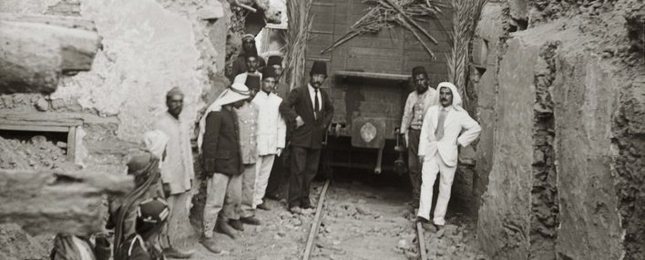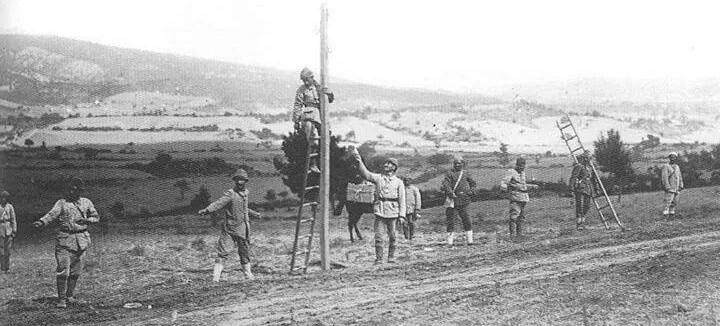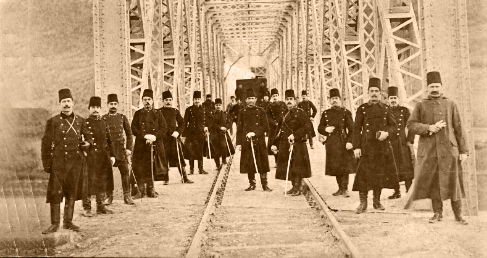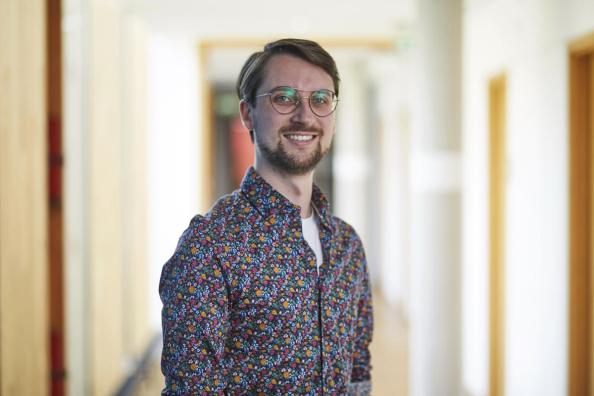
Image 1: Transcription of a chant based on visualization by the Photophonograph (© Metfessel, Milton (1928). Phonophotography in Folk Music. American Negro Songs in New Notation. Chapel Hill, NC: University of North Carolina Press, p. 79.).
Image 2: Visualization of a chant of the Ute by the Oscillograph (© Densmore, Frances (1922). Northern Ute Music. Washington, DC: Washington Government Printing Office, p. 106.).
Image 3: The ethnomusicologist Charles Seeger at his Melograph (© UCLA Los Angeles. Ethnomusicology Archive, https://digital.library.ucla.edu/catalog/ark:/21198/zz0025m6zm.).
The Politics of Music Capturing. Music Information Retrieval and Ethnomusicological Research, 1900–1970
Christopher Klauke’s research project explores the ways in which concrete political structures and beliefs have influenced the historical development, establishment, and operativity of the knowledge techniques of music capturing.
Music Information Retrieval has become a central and widely used resource for today’s data-driven music culture. It enables the algorithmic transcription and analysis of music and is used by, for example, music streaming platforms and large-scale musicological projects. Surprisingly, this knowledge technique emerged within disciplines peripheral to the humanities: ethnomusicology and folk music research, which were shaped by colonial, eugenic, or emancipatory assumptions. From 1900 onward, various machines—such as phonophotographs, melographs, or spectrographs—were developed that were able to address and translate the audio signals of non-Western music recordings into diagrammatic forms.
Methodologically, the project is situated in media history, specifically Kulturtechnikforschung, and in postcolonial history of knowledge. It draws on recent publications in the fields of science and technology studies, musicology, and visual studies.
Christopher studied musicology, music pedagogy, and art history at Justus-Liebig-Universität Giessen for his BA. He earned his MA in musicology at Humboldt-Universität zu Berlin in 2022 with a thesis on techniques of measuring and listening in the Phonogramm-Archiv Berlin.
Publications & Presentations
Articles (Selection):
Klauke, Christopher, and Valentin Ris (under review). “Epistemologien, Praktiken und Politiken der Organologie: Überlegungen zu einer kulturtechnisch orientierten Instrumentenforschung.” In: Instrumentenforschung 2.0, edited by Alan Ruben van Keeken and Johanna Imm. Osnabrück: Olms.
Klauke, Christopher (2025 – in print). “Appunns Tonometer. Zu den Politiken eines zeitkritischen akustischen Interfaces im Phonogramm-Archiv Berlin.” In: Akustische Interfaces, edited by Christoph Borbach and Robert Stock. Wiesbaden: Springer.
Klauke, Christopher, and Raphael Börger (2024). “Beiträge zur Musikwissenschaft. Anmerkungen zu einer musikalischen Wissensmaschine in Ost-Berlin 1959–1990” In: Musikwissenschaftliche und musikalische ›Schulen‹? Strukturen, Analyse, Dynamiken, edited by Jakob Uhlig. online: musicon.
Klauke, Christopher (2024), "Von der Klang-Sammlung zur Klang-Daten-Sammlung Praktiken der Datafizierung in der Vergleichenden Musikwissenschaft um 1900.“ In: Kunsttexte (Themenheft: Auditive Perspektiven: Klänge sammeln), 2024/2.
Klauke, Christopher, Anne Delle, Alan Fabian, José Gálvez, Steffen Just, and Veronika Muchitsch (2023). “Klangliche Materialität(en) von Musik — Versuch einer So(u)ndierung in den Popular Music Studies. Ein Forum.” In: All the Things You Are. Populäre Musik und materielle Kultur, edited by Ralf von Appen und Peter Klose. Bielefeld: transcript.
Klauke, Christopher (2020). “Gemeinschaftsstimme. Klangpolitik, Volkskörper-Werden und Massensingen im Nationalsozialismus.” In: Wissen im Klang. Neue Wege der Musikästhetik, edited by José Gálvez, Jonas Reichert, and Elizaveta Willert, 79–91. Bielefeld: transcript.
Presentations:
December 2023: "Zwischen Datenkolonialismus und Pawnee-Ontologie. Politiken der Musikerfassung in der Vergleichenden Musikwissenschaft um 1900,“ Invited Presentation at the Colloquium Series „Wissenschaftsgeschichte / Praxeologien der Wahrheit,“ Universität Erfurt.
July 2023: “Politiken der Musikerfassung,” Invited Presentation at the Colloquium of Musicology/Sound Studies, Universität Bonn.
May 2023 with Valentin Ris: “Interfacing Micro-Time Machines 1900/2000. The Cultural Techniques of the Tonometer and DAW,” Instruments, Interfaces, Infrastructures. An Interdisciplinary Conference on Musical Media, Harvard University.
January 2023 with Christina Dörfling: “Arbeitsmethode... team work – Popularmusik-Forschung in Ost-Berlin,” Populäre Musik und ihre Geschichte. Sammeln - Forschen - Publizieren, Lippmann+Rau Musikarchiv Eisenach.
October 2022: “Between Music-Anthropological Research and Culture Regulation: Cybernetic Investigations of Popular Music in the GDR 1957–1970.” as part of the panel with Alan van Keeken “Scientific Investigations and Critique of Popular Music and Sound in the GDR and FRG 1950–1970: Two Case Studies.” Parallelgesellschaften: conference of the Gesellschaft für Popularmusikforschung and the International Association for the Study of Popular Music, Universität für Musik und Darstellende Kunst Wien.
May 2022: “Appunns Tonometer. Zur Kolonialität eines akustischen Interfaces zur Vermessung von Musik im Phonogramm-Archiv Berlin,” Akustische Interfaces, Humboldt-Universität zu Berlin.
December 2021 with Raphael Börger: “Zu einer musikalischen Wissensmaschine Ost-Berlin 1959-1990,” DVSM-Symposium: Musikwissenschaftliche und musikalische ›Schulen‹? Strukturen, Analyse, Dynamiken, online.
November 2021: Poster “Appunns-Tonometer. Zur concrétisation eines Instruments, das andere Instrumente vermisst, oder: eine Organologie der Organologie um 1900,” Instrumentenforschung 2.0, Martin-Luther-Universität Halle-Wittenberg.
October 2021 with Lorenz Gilli and Steffen Just: Round Table “Klangliche Materialität der Musik. Eine Soundierung” (speakers: Alan Fabian, José Gálvez, Maren Haffke, Johanna Imm, Veronika Muchitsch, Katharina Preller), All the Things You Are. Populäre Musik und materielle Kultur, Technische Universität Dortmund.
November 2020: “Volkskörper-Werden. Körperpolitische Dimensionen der gesanglich artikulierten Gemeinschaftsstimme im Nationalsozialismus,” Body and Corporeality in 20th and 21st Century Music, University of Music and Performing Arts Graz.
Organized Events:
March 2021 with Raphael Börger: conception, coordination and opening presentation of the online symposium „Musik als Wissensmaschine — Experiment einer Hörenden Philosophie und Kulturwissenschaft. Ein Symposium der HUG“ (funded by Humboldt Universitäts Gesellschaft), Dept. for Musicology and Media Studies, Humboldt-Universität zu Berlin. https://musikalswissensmaschine.de/ ; https://www.hug-berlin.de/projects/musik-als-wissensmaschine/.
November 2020 with Sandra Bogdanovic, Jasmin Goll and Pia Wolff (as „Forschungsgruppe Musik und Intermedialität" of DVSM): conception, coordination and opening workshop unit of the online workshop „Musik und Intermedialität,“ Dept. for Musicology and Media Studies, Humboldt-Universität zu Berlin.
Ignorance in the Age of Text: “Ignorant” Readers and Their Reading in Eighteenth- and Nineteenth-Century Britain
Jakob K. Hellstenius’s project seeks to understand the reading practices of those readers in Britain who were deemed “ignorant” in the eighteenth and nineteenth centuries.
“Ignorant” readers were berated by elites for reading “uninstructive” texts that did nothing to change their material and intellectual poverty, but instead deepened their ignorance—yet such reading was anything but a meaningless pastime.
Jakob explores, first, how such readers’ understanding of religion, economics, intimacy, human nature, and more was shaped by the texts they read; and second, their practices of reading, which mediated the creation, not of ignorance, but knowledge that was legitimized by a different epistemology and was opaque to those unaware of its foundations.
Methodologically, Jakob applies a range of approaches, from traditional archival work to methods from science and technology studies and the digital humanities.
Jakob received both his MA and BA from the University of Oslo. His MA explored the effects of the diversification and universalization of the written word on the reading practices of common readers in nineteenth-century Norway. He was the recipient of the UiO:Norden and Foreningen Norden’s Master thesis scholarship and the Master thesis scholarship of the LO (Norwegian Confederation of Trade Unions) for studies in labor history.
Publications & Presentations
Articles:
Hellstenius, Jakob Kaaby (forthcoming). “Kan nasjonen føles?” In Introduksjon til emosjonshistorie, edited by Eirinn Larsen and Jón Viðar Sigurðsson. Oslo: Universitetsforlaget.
Hellstenius, Jakob Kaaby (2021) “The Pious, the Obstinate, and the Fickle: Common Readers in 19th-Century Norway.” Master’s thesis, Universitetet i Oslo.
Hellstenius, Jakob Kaaby (2020) “Steder uten mørke.” Molo 11: 61–68.
Hellstenius, Jakob Kaaby (2020) “Ubehaget i nasjonen.” Fortid 17, no. 2: 64–73.
Hellstenius, Jakob Kaaby, Sigurd Bækkelund, and Magne Klasson (2020). “Historikeren: Kristin Asdal.” Fortid 18, no. 3: 4–8.
Reviews:
Hellstenius, Jakob Kaaby (2020). “I skyggen av folkeopprøret,” review of La guerre des pauvres, by Éric Vuillard. Fortid. https://www.fortid.no/spalter/bokmeldinger/2020/hellstenius-de-fattiges-krig.html.
Hellstenius, Jakob Kaaby (2019). Review of Tilbake til Lemberg, by Phillip Sands. Molo Tidsskrift. https://molotidsskrift.no/bokanmeldelse-tilbake-til-lemberg/.
Presentations:
April 2018: “Foucault og historien.” As part of Kulturutvalget’s autumn program at Chateau Neuf, Oslo. Presented with Ellen Krefting, Fredrik Engelstad, and Svein Atle Skålevåg.
September 2017: “Hva er historisk sannhet?” As part of Kulturutvalget’s spring program at Chateau Neuf, Oslo. Presented with Erling Sandmo and Tor Egil Førland.
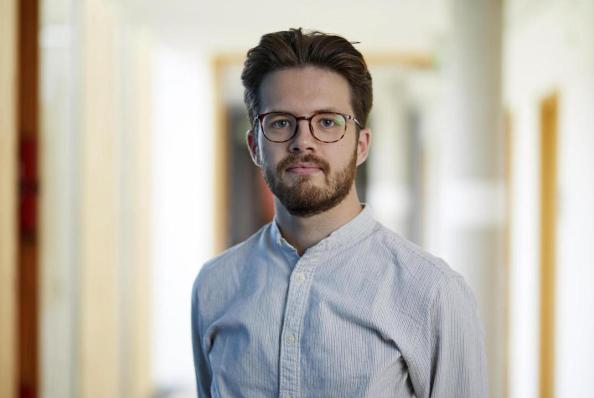
jhellstenius@mpiwg-berlin.mpg.de
Image 1: Dic Aberdaron (Richard Robert Jones) (1780–1843) was a Welsh traveller and polyglot (© Llyfrgell Genedlaethol Cymru / The National Library of Wales).
Image 2: An elderly man is depicted reading for leisure in Saturday night by Erskine Nicol (© The Hunterian, University of Glasgow).
Image 3: In 'A Dame's School' (1887) photographer Peter Henry Emerson staged a lesson on reading in East Anglia, England (© Peter Henry Emerson, Collection of National Media Museum/The Royal Photographic Society).
Image 1: A dye label of BASF synthetic indigo packaging for the Chinese market (© BASF Corporate Archives.).
image 2: Chemists at BASF's indigo laboratory in Ludwigshafen. Synthetic indigo became one of the bestsellers in China (© BASF Corporate Archives.).
Image 3: Defag employee Rudolf Schiffler explaining the correct application of chemical dyes to a Chinese customer (© Estate of Marion Schiffler.).
Colorful Encounters: Nature, Science, and Dyes between Europe and China, 1880–1950
In the context of the industrialization of chemistry and global modernization from the late nineteenth to the mid-twentieth century, Lejie Zeng’s project examines how the encounter between synthetic dyes from Europe and natural dyes from China shaped the exchange between “nature-based” and “science-based” bodies of knowledge in different regions.
By recovering the materiality of color and tracing how dyes operated across local, cross-regional, and global boundaries, bringing together seemingly disparate human actors (dyers, chemists, compradors) and gender groups (male elites, modern women) to co-compose global knowledge, the project challenges long-established dichotomies between East and West and between experimental science and traditional crafts.
Knowledge and material exchanges across uneven borders have never presented a romantic picture, but are intricately entangled with the redistribution of global resources and geopolitical power. Lejie seeks to mark out a dynamic space of frictions, confluences, and negotiations, asking why and how these boundaries were formed.
Lejie Zeng holds a BA in media arts from Tongji University in Shanghai and an MA in media studies from Humboldt-Universität zu Berlin, where she won a Humboldt Research Track Scholarship in 2021. During her studies, she was a research assistant at the Humboldt-Universität and a researcher at the Berliner Werkstatt für Sozialforschung.
Publications & Presentations
Presentations:
December 2023: "Supplying Colors and en-Route Science: German Synthetic Dyestuffs in Modern China in the Early 20th Century," HASS Colloquium Series, Singapore University of Technology and Design (SUTD).
March 2023: "Making China Blue: Dyestuff Production and Vernacular Industrialism in Modern China, 1900s-1940s," panel talk at The Association for Asian Studies Annual Conference (AAS), Seattle.
Agricultural Knowledge in New Persian Texts, 1200–1600
How, in what fields, and by which authorities do premodern New Persian agricultural texts stake claims to contain knowledge? How does evidence in manuscripts from 1200–1600 CE support or challenge modern constructions of a stable tradition of Persian agriculture?
Addressing these questions, Riaz Howey’s dissertation project focusses on a reading of the Ās̱ār va Aḥyāʾ, or Vestiges and the Living, a partially surviving agricultural treatise attributed to an elite figure of the Ilkhanid period, Rashīd al-Dīn Fażlullāh Hamadānī (1247–1318). The text is compared with other Persian tracts on agriculture, as well as relevant sources in other languages, investigating how readers, translators and copyists situated their textual practices in this field.
Particular attention is paid to changes in the social, technical and material conditions under which literate agricultural knowledge was performed and reproduced. The project engages with the history of science in the early Islamic World, in Persian-language sources and in the Mongol Empire.
Riaz Howey completed an MA in global history at the Freie Universität Berlin in 2020. At the MPIWG, he is currently also a predoctoral fellow in the Department III working group “Agriculture and the Making of the Sciences.” He is enrolled as a doctoral student at the University of Bonn in the Department of Islamic Studies and Near Eastern Languages.
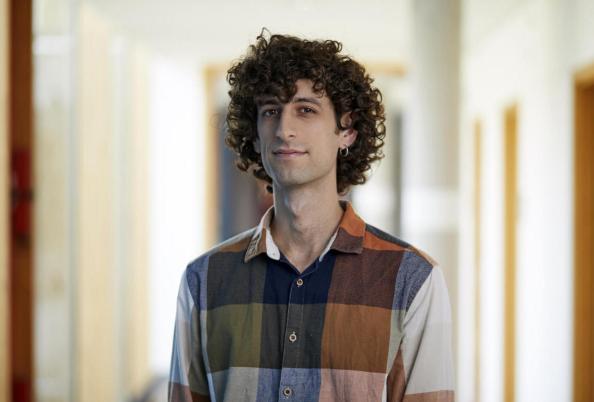
Image 1: Detail (f.92v) from an illustrated fourteenth century copy of Bīrūnī’s Arabic Chronology of Ancient Nations showing the prophet Bihāfarīd with a man using a spade (© The University of Edinburgh).
Image 2: Fragment of a page (mounted with F1937.39) showing the end of the mulberry section and beginning of the olive section in an illustrated copy of the Persian Nuzhatnāmih-yi ‘alāyī (The Book of Counsel of ‘Alā) of Shahmardān Ibn Abī al-Kheir Rāzī (© Shahmardān Ibn Abī al-Kheir Rāzī, Smithsonian National Museum of Asian Art, https://asia.si.edu/object/F1937.38/).
Image 3: Fragment of a page (mounted with F1937.38) showing an illustration of an apple tree with two poppy plants with an instruction for a preparation from an illustrated copy of the Persian Nuzhatnāmih-yi ‘alāyī (The Book of Counsel of ‘Alā) of Shahmardān Ibn Abī al-Kheir Rāzī (© Shahmardān Ibn Abī al-Kheir Rāzī, Smithsonian National Museum of Asian Art, https://asia.si.edu/object/F1937.39/).
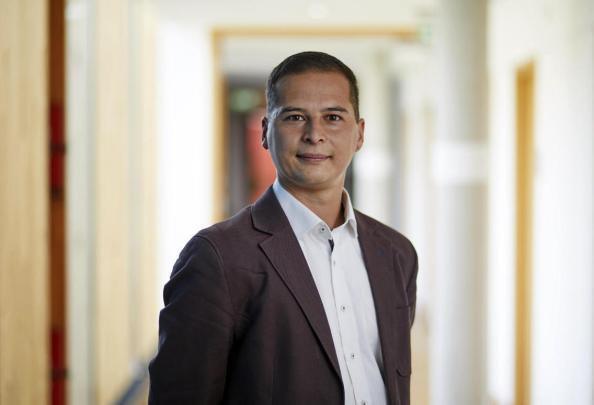
saquaijtaal@mpiwg-berlin.mpg.de
Image 1: A fragment of a cuneiform tablet from the first half of the 1st millennium BCE containing commentaries on the 5th tablet of the astrological omen series Enūma Anu Enlil (© The Metropolitan Museum of Art, New York.).
Image 2: A fragment of a cuneiform tablet from the late 1st millennium BCE containing astrological omens relating to the life of an individual as well as to state affairs (© Royal Museums of Art and History, Brussels.).
Image 3: A fragment of a cuneiform tablet from the first half of the 1st millennium BCE containing commentaries on the 5th tablet of the astrological omen series Enūma Anu Enlil (© The Metropolitan Museum of Art, New York.).
Science before Nature: An Epistemology of Perspectives in the Commentaries of Cuneiform Scholarly Traditions
Satria Quaijtaal’s project investigates commentaries belonging to scholarly traditions from first millennium BCE Mesopotamia.
The commentaries are written in the Sumero-Akkadian cuneiform script and explore the semantic landscape of literary and divinatory texts through analogical hermeneutics. Satria is interested in the principles of epistemic practices before the conception of natural philosophy and in the ontological ideas that informed them.
Cuneiform commentaries are the product of Babylonian and Assyrian scholars reflecting on older knowledge traditions and the cuneiform script as resources of knowledge. Satria seeks to uncover the commentators’ epistemic objects by analyzing the methods, questions, reasoning, and terminology that they used to engage with culturally significant literary narratives, lexical works, medical compendia, and divinatory lists of observations and predictions.
The goal of the project is to develop a deeper understanding of how the cuneiform system and hermeneutic analysis provided ancient scholars with an ontological framework and epistemic tools for investigating the experienced world through the observation and interpretation of phenomena, language, and writing.
Satria Quaijtaal holds a BA and MA in ancient Near Eastern languages and civilizations, completed at Freie Universität Berlin in 2017 and 2022. He wrote his MA thesis on “The Old Babylonian Syllabary of Akkadian Texts from Elam.”
“Usual Suspects” in “Unusual Locations”: Infrastructure, Maintenance, and Expertise in the Late Ottoman Empire (1855–1922)
Zeynep Ecem Pulaş’s PhD project analyzes the emblematic technologies of the nineteenth century, the telegraph and railway, in the Ottoman Empire through the lens of maintenance and repair.
It aims to show how the unrecognized labor of Ottoman actors who maintained and repaired these technologies underpinned not only the Empire’s economic and political apparatus, but also the wider functioning of global transport and communication networks.
Examining a mixed set of elite and non-elite Ottoman actors—engineers, telegraph clerks, local artisans, technicians, skilled workers—along with their ideas and practices, the dissertation asks: How did these Ottoman experts gain, produce, and circulate knowledge through their direct engagement with the technologies?
The study of the repair and maintenance practices in the Empire's two most extensive, economically demanding, and expertise-dependent projects will add to a new, decentered history of knowledge and technology that transcends Europe and innovation-centered approaches.
Zeynep completed a double major in history and political science at Istanbul Bilgi University. During her MA in global history at Freie Universität and Humboldt-Universität zu Berlin, she worked at the research center re:work and on the digital humanities project of the Hannah Arendt Critical Edition.
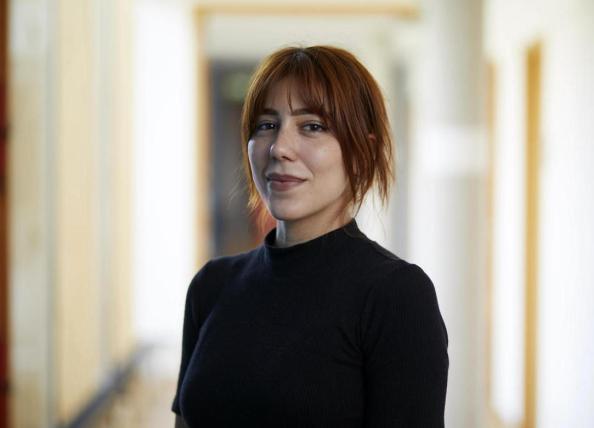
zecempulas@mpiwg-berlin.mpg.de
Image 1: Hejaz Railway, 1907.(© Ekinci, Ekrem Bugra. ‘Daily Sabah’. Hejaz Railway: A Historic Line to Islam’s Holiest Cities, n.d. https://www.dailysabah.com/feature/2016/10/28/hejaz-railway-a-historic-line-to-islams-holiest-cities.)
Image 2: A group of Ottoman soldiers fixing the telegraph poles. (© Bahadır, Osman. Osmanlılardan Cumhuriyete Elektrik. Birinci Basım. İstanbul: Anahtar Kitaplar Yayınevi, 2020.)
Image 3: Students of the Military Academy pose in front of a bridge of the Istanbul-Ankara railroad line opened in 1892. (© The Yasser Alwan Collection, Akkasah: Center for Photography, Engin Ozendes Collection_ref220.)
